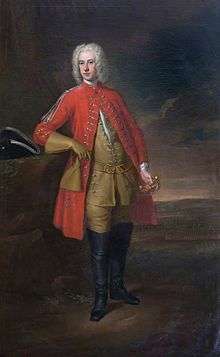John Cope (British Army officer)
| Sir John Cope KB | |
|---|---|
 John Cope, ca. 1730 | |
| Born | 1690 |
| Died | 1760 |
| Allegiance |
|
| Service/branch |
|
| Rank | Lieutenant General |
| Commands held |
Cope's (39th) Regiment of Foot Commander-in-Chief, Scotland |
| Battles/wars | |
| Awards |
Order of the Bath (Knight Companion) |
| Other work | Member of Parliament |
Sir John Cope KB (1690–1760) was a British general and member of parliament. Although a successful officer in the Wars of the Spanish and Austrian Succession, he is best known for his defeat at the Battle of Prestonpans in 1745.
Early life and military advancement
Cope was the oldest son of Lieutenant-Colonel Henry Cope of Icomb, Gloucestershire. His grandfather disapproved of his father's marriage and entailed the family estate so that John could not inherit it when his father died. John was educated at Westminster School around 1700, and appointed page to Lord Raby, then ambassador at Berlin, in 1706. Raby commissioned Cope a cornet in his regiment, the Royal Regiment of Dragoons in 1707, then fighting in Spain. Cope was committed to the care of General Stanhope, who appointed him an aide-de-camp in 1708. These connections secured Cope's rapid advance. He purchased a captaincy in Wade's Regiment of Foot in 1709, which he shortly thereafter exchanged for one in Lord Peterborough's Regiment of Dragoons. On 7 October 1710, he became captain and lieutenant-colonel in the 3rd Foot Guards. On 1 April 1712, he was appointed lieutenant-colonel of Macartney's Regiment of Foot, but immediately exchanged to the same position, on 2 April, in Wynne's Regiment of Foot. He was breveted a full colonel in 1713, with effect from 17 November 1711, and went on half-pay in 1713 at the close of the War of the Spanish Succession. Cope's rise during the war had been rapid, and he had also married Jane, the daughter of the wealthy Anthony Duncombe. With the later he had one son, James Cope (c.1709–1756)[1]
Parliament and War of the Austrian Succession
Cope received the lieutenant-colonelcy of the 2nd Foot Guards in 1715, and of the 1st Troop of Horse Grenadier Guards in 1720. He now sought to enter Parliament on the Government interest. A steady supporter of Robert Walpole, he was returned for Queenborough in the 1722 election. At the 1727 election, he was put in for Liskeard instead. His rise in the army continued: he was appointed colonel of the 39th Regiment of Foot in 1730, and transferred to the 5th Regiment of Foot in 1732. He unsuccessfully contested Orford in the 1734 election. Promoted brigadier-general in 1735 and appointed colonel of the 9th Regiment of Dragoons on 27 June 1737, he obtained a seat at Orford in a by-election in 1738.[1]
Promoted major-general on 2 July 1739, Cope became colonel of the 7th Regiment of Dragoons on 12 August 1741. He did not stand in the 1741 election. In the summer of 1742, he went abroad with the Pragmatic Army under Field-Marshal Lord Stair to fight in the War of the Austrian Succession. He led the second line of cavalry at the Battle of Dettingen, and after that success was promoted lieutenant-general on 7 February 1743 and made a Knight of the Bath on 12 July.[1]
Scottish command

In 1745 in his role as Commander-in-Chief in Scotland, Cope was in command of the government forces at the Battle of Prestonpans and was defeated by the Jacobite army of Charles Edward Stuart (Bonnie Prince Charlie). His men broke and ran as the result of a highland charge.
The battle is commemorated by Adam Skirving's heavily mythologized song Heigh! Johnnie Cowp, are ye wauken yet? (Hey Johnnie Cope, are you awake yet?).
In his popular book The Life of Colonel Gardiner (1747), the nonconformist author Philip Doddridge alleged that when Cope surveyed the forces that Charles Edward Stuart had amassed against him, he chose to gain the dubious honour of being the first British general to deliver the news of his own defeat by fleeing the battle and leaving his men without a commander.[2]
However, Cope was later court-martialled and exonerated of such charges:
The Report of the Board's proceedings was published in 1749. Anyone who scrutinizes it closely can only conclude that the Board was correct. What emerges from the pages is not, perhaps, the portrait of a military genius but one of an able, energetic and conscientious officer who weighed his options carefully and who anticipated - with almost obsessive attention to detail - every eventuality except the one which he could not have provided for in any case: that his men would panic and flee.[3]
Cope is said to have made a large amount wagering that his replacement (Lt Gen. Henry Hawley) would be defeated by the clans just as he had been.[4] Though cleared of any charges, Cope never commanded in the field again and died in 1760.
References
- 1 2 3 Newman, A. N. (1970). "COPE, John (1690-1760).". In Sedgwick, Romney. The House of Commons 1715-1754. The History of Parliament Trust.
- ↑ Cadell, General Sir Robert (1898), Sir John Cope and the Rebellion of 1745, pp. 2–4
- ↑ Martin B. Margulies, History of Scotland magazine
- ↑ Tomasson & Buist "Battles of the 'Forty Five"
This article incorporates text from a publication now in the public domain: Wood, James, ed. (1907). "article name needed". The Nuttall Encyclopædia. London and New York: Frederick Warne.
External links
| Wikisource has original works written by or about: John Cope |